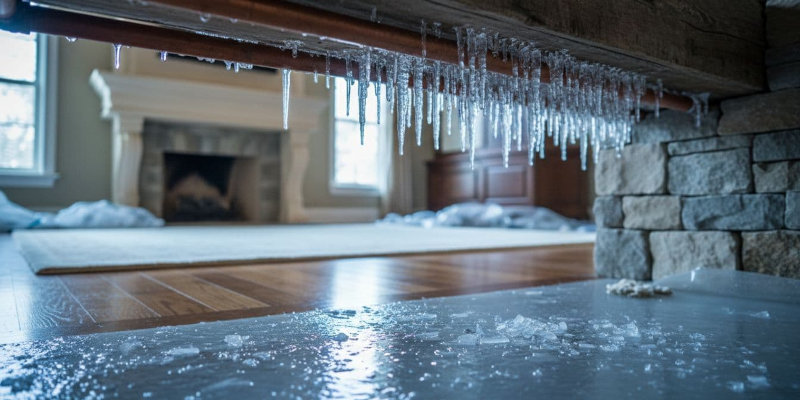Ever notice a chill by the window even with the heat on? Those small drafts are sneaky. Air leaks let cold air creep in and push warm air out, which makes your furnace run longer, burn more fuel, and raise your bill. In this guide, you will learn how leaks stress your furnace, how to spot them fast, simple DIY fixes, and when to call a pro. Let’s keep more heat inside, not outside. Let’s start lowering heating bills!
Why tiny air leaks raise your heating bill and strain your furnace
Cold air slips in through gaps, and warm air escapes through cracks. That is infiltration and exfiltration in plain terms. Your thermostat senses the drop, so the furnace kicks on more often. Longer run time, more cycles, and more starts wear parts faster. That means repairs show up sooner and filters clog quicker.
Drafts also create cold spots, so some rooms feel chilly while others run hot. Your furnace tries to even it out, but leaks fight against it. Dust can get pulled in through gaps, then your filter loads up, airflow drops, and efficiency falls. Fixing the leaks helps comfort, cuts noise from whistling gaps, and lowers fuel use without touching the thermostat.
What small drafts do to airflow and run time
Drafts force the furnace to work harder to hold the set temperature. If the thermostat sits near a draft, it can short cycle, turning on and off too fast. That leads to temperature swings and wasted fuel. In other rooms, the furnace may run longer than it should, trying to chase lost heat.
Easy signs you have air leaks at home
- Chilly spots near windows, doors, or baseboards
- Curtains move on windy days, even with windows shut
- Whistling or rattling around frames
- Filters get dusty or dirty sooner than normal
- Heating bills jump compared to last year
- Rooms that never feel warm, no matter the setting
Find and fix common air leaks in a weekend
Start simple. Test for drafts, locate the biggest leaks, then seal those first. Work from obvious spots to hidden ones. Focus on doors, windows, attic access, and any visible gaps. Use safe materials and read labels. If you have gas appliances, keep clearances, do not block vents or flues, and leave combustion air paths open. A careful day or two of sealing can make a big difference.
Quick tests you can do today
- Paper or dollar bill test at door seals; if it slides out, the seal is weak.
- Incense or a smoke pencil on a windy day; watch the smoke pull toward leaks.
- Flashlight test at night; light shining through frames or trim means gaps.
- Feel for drafts around outlets and baseboards with the back of your hand.
- Use a phone thermal camera if you have one to spot cold streaks.
Where leaks hide in most homes
- Attic hatch or pull-down stairs
- Rim joists and sill plates in the basement
- Window and door frames
- Dryer vents
- Plumbing and wire penetrations
- Recessed lights
- Fireplace dampers
- Leaky ducts in the attic or crawlspace
Simple DIY sealing that actually works
- Add weatherstripping to doors and windows
- Use caulk for small gaps around trim and frames
- Low-expansion spray foam for larger cracks
- Foam gaskets behind outlet and switch plates on exterior walls
- Door sweeps at thresholds
- Mastic and UL 181 foil tape for duct joints
Do not seal flues, weep holes, or dedicated combustion air openings.
When to bring in a pro for testing and duct sealing
Pros use tools that find what you cannot see. A blower door test and duct leakage test locate hidden losses and guide targeted repairs. If you have a gas furnace, a combustion safety check confirms safe draft, proper fuel or gas pressure, and low carbon monoxide. Ducts can be sealed, airflow balanced, and the furnace tuned for better heat and quieter operation. Book service before the first cold snap for the best scheduling and faster savings. For more maintenance insights, see Signs Your Heating System Needs Maintenance.
Blower door and duct tests find hidden losses
A blower door gently depressurizes your home, which makes leaks easy to measure and see. Duct tests show where air escapes inside walls, attics, or crawlspaces. The results point to the biggest wins first, often attic bypasses and duct joints.
Seal ducts and tune the furnace for safe, efficient heat
Techs seal ducts with mastic, reconnect loose runs, and balance airflow to each room. They check gas or fuel pressure, verify carbon monoxide is within safe limits, and confirm the thermostat settings. A clean filter and steady airflow keep heat even and steady.
How fast can air sealing pay off?
Savings vary with leak size and energy prices. Many homes see payback within a season to a few years. Comfort improves right away, and drafts and noise drop as soon as you seal the big gaps.
Conclusion
Small leaks make your furnace work harder, burn more fuel, and cost you money. Start with quick tests, seal the obvious gaps, then call a pro if rooms still feel uneven or bills stay high. Act now, before winter settles in, and enjoy warmer rooms and lower bills all season.




